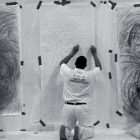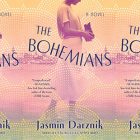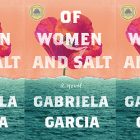“Uninhibited Openness”: An Interview with Dario Robleto, Materialist Poet
Conceptual artist Dario Robleto has been aptly described as an alchemist, cultural archeologist, and “raconteur in the ancient way.” By his own definition, he is a “materialist poet”—a term that encapsulates his method of creating sculptural responses to lyrical material lists that mediate on the human condition. From black swan vertebrae to stretched audiotape recordings of Sylvia Plath, braided mammoth hair to melted bullet lead, Robleto’s sculptures generate narrative resonance between unconventional and often elaborately altered objects. With emotional honesty and tangible curiosity, his resulting exhibitions launch timely and timeless inquires into war, healing, memory, and the evolutionary relationship between creativity and loss.
Above all, Robleto’s art inspires responsibility for remembrance. His installations cultivate intimacy with history, using sensory particulars to excavate forgotten yet defining threads within the fabric of collective thought. Reaching across the boundaries of various disciplines, Robleto’s work poignantly contends that our understanding of human origins should be as sophisticated as the modern technology we’re now moving toward. In his own words, “The present is the accumulation of the past.”
Robleto has had over 30 solo exhibitions, most recently “The Boundary of Life is Quietly Crossed” at the Menil Collection, and “Setlists for a Setting Sun” at the Baltimore Museum of Art. He is currently an Artist Research Fellow at Rice University in Houston, where he lives and works, and was recently named Texas State Artist.
Lara Palmquist: As a literary form, poetry is distinguished for its equal emphasis on shape, meaning, and sound. In many ways, your own work shares this triptych focus: your recent installation at the Menil incorporated a range of materials that included heartbeats resurrected from 19th century medical charts, melted vinyl records salvaged from the deep ocean, and written stories that illuminated the history of cardiology. What are your views on the fluctuating boundaries between music, visual art, and poetry?
Dario Robleto: The way I view boundaries within art, or any field, is complete and uninhibited openness and transparency. This doesn’t mean there aren’t tensions, contradictions, or dead ends. There are many, but I would not know what those are without the belief that art has a responsibility to navigate through every field. Although I have always felt it instinctually, it has taken me many years to more clearly understand the value art has in cross-pollinating with other fields. This can be a touchy subject within the arts as there is still, I believe, a misguided attitude that art is trying to be something, or live up to standards it is not designed to do when it reaches out to areas like physics or medicine or history. I don’t accept this self-imposed limitation about what art should be.
One of the great joys of being an artist is of course participating in the creative act. But another joy that my particular practice has afforded me is that I have had to become a student of the history of creativity itself. And that means creativity in any form it chooses to take whether through art, science, history, mourning rituals, or spirituality to name a few. As useful as those categories can sometimes be, the world is filled with incredible objects and stories that don’t always fit squarely into them. Like arguing the artistic merits of a new artificial heart design, or how a sculpture could aid in neuroscience, or how something as seemingly simple as the craft of braiding hair can speak to the psychology of loss. We become so rigid in our categories that having these discussions doesn’t feel intuitive. Certain gestures—through a perfect blending of material, process, and potential meaning—transcend the field they originated in and require multiple lenses through which to view them.
This is where I see the real value of the mutability of art coming into play. If one accepts, as I do, that art has a broader moral responsibility to actively engage with the world at large and bring its unique skills to the table, then it is up to the artist to find where he or she can make an impact. Some of the subjects you know I am currently deeply immersed in, such as the first recording of a human heartbeat to escape the influence of the Sun and enter interstellar space, or the implications of resurrecting sounds that pre-date the invention of sound recording, or the radical re-envisioning of a defining feature of our humanity through the invention of a “beatless” artificial heart, are all moments that completely transcend their field of origin. We will need the poet as much as the scientist to help understand what has been created. Because, as I have learned from working with experts in these fields, the poetic, artistic, or philosophical implications of their breakthroughs are not what is keeping them up at night, nor should it. The passions that led them there should continue to do so, but certainly someone should be losing sleep over what it will mean to fall in love, or write a novel, or enter a confessional without a beating heart, and it should be our artists doing so. At minimum we need artists at these boundaries bearing witness to these moments.
LP: One of the sculptures that first led me to your work, and one which continues to inform my thinking, is “A Sadness Silence Can’t Touch.” This piece includes casts of Civil War “pain bullets” (which soldiers would bite on while undergoing surgery) made from dissolved audiotape recordings of war poets such as Whitman, Tennyson, and Eliot, among others. When we talk of art performing witness, the tradition of war poetry immediately comes to mind.
To me, an essential component of what it means to bear witness is prioritizing observation over explanation, and inviting active reflection. One of the aspects I most admire about your exhibitions is how you incorporate specificity while also allowing an audience to draw their own conclusions. I’m hoping you can speak more about how you generate this space for meaning-making, especially when dealing with the historical record.
DR: This piece, and all my work really, is driven by two contradictory desires: the need for rigorous specificity and for poetic ambiguity. The meaning-making you speak of is often generated in the tension of their creative entanglement. The desire for specificity is driven by two impulses that I hold dear and inform each other—the concept of bearing witness and the scientific method. But I will just touch on the bearing witness aspect for a moment.
As we are alluding to here, bearing witness gives the act of observation a moral dimension that I think artists can be particularly skilled at. We are observers by nature and the idea that injustices of all varieties will at minimum be observed, be accounted for, be remembered by the artists’ eyes is a powerful cultural tool. It is not just the injustices that our eyes can observe, but also, and maybe more importantly, the beautiful history of the creative response to loss that is as timeless as loss itself. War and conflict may be a universal human trait but so is the equally human desire to confront these tragedies through creativity and hope. One of the most powerful and meaningful ideas I have ever encountered is the idea that creativity itself is intimately linked with loss at an origin level; the idea that guttural cries or heaving from loss were the seeds for rhythm, or that carving a seashell or stone to adorn the dead birthed sculpture. Today, we can grab countless massive tomes about every war documented, but the parallel history of aesthetics through loss is not one easily discovered and artists are uniquely skilled to aid in this rediscovery.
Every artist can approach this in different ways. In my practice, I don’t feel I have a right to speak to other people’s loss or love or struggle until I’ve “earned” it, so to speak, and part of earning it for me means the most diligent, dedicated engagement with the subject that is about details, nuance, and depth. And it is also clearly a form of love that motivates me, and I want to tap into that irrational curiosity that falling in love can often incite—that feeling that you need to know everything right now! Because my process hinges on “earning it”—through rigorous research, revealing lost details, empathetic embodiment—it is natural that the work accounts for these details in its final form. But this is not in an effort to over-explain or spoon feed meaning to a viewer. I always assume the viewer is intelligent, independent, and engaged. I am still trying to open up an unexpected new space, and the old adage “truth is stranger than fiction” can be useful in understanding my approach. Through this type of detailed observation, the specifics cause momentary disbelief, wonder, strangeness, and the poetic ambiguity I equally crave. Simply stating the materials I use in a direct way—men’s wedding ring finger bones coated in melted bullet lead, Icelandic lava, mourning frame from another’s loss—unexpectedly produces a strangeness that seems implausible. But then, much of the artistic leap I am making is in imagining if such materials could exist and then actually finding and manipulating them. Mystery and ambiguity then find their way back into the object.
LP: As you beautifully state here and elsewhere, your work is partly motivated by deeply felt passions and a relentless curiosity for your subjects. You’ve also expressed that your work arises from challenges you set for yourself by playing with poetic phrases, inviting a sort of liberated wonder through language prior to addressing the practicalities of creating an object. Your process then seems to involve, as you say, “imagining if such materials could exist and then actually finding and manipulating them.”
While considering how your sculptures transform an audience’s way of seeing, I’m also interested in how your artwork, and in particular these written challenges, act as a teacher for you. In many ways your sculptures feel drawn to matters of extremity, be it the Golden Record leaving the solar system, or physical limits such as the human capacity to remember. Can you talk about a particular project that pushed you emotionally or intellectually to discover new insight, reorganize your thinking, or recognize evidence for something you already felt instinctively to be true?
DR: Well, you have asked a question that gets to one of the core motivations as to why I have chosen to be an artist. I would find it impossible to commit to an idea unless I knew there was a guaranteed chance I would be transformed emotionally and intellectually while exploring it. I need to feel a bit terrified about what’s at stake—either through what I may need to see or personal changes I may need to make in myself—in order to justify giving my life over to it. I tend to work on big picture topics for at least 5 years, but usually more. The production of an individual work, from research to material exploration and production, can easily take 2 or more years. Essentially, starting a project is entering an intimate relationship. If you are not changing as that relationship demands, then something is wrong. Whatever I hope art’s social and cultural function may be, no artist can avoid the personal ramifications that come with this life. But, for me, I have come to realize that my ambitions for the social and cultural functions of art are directly tied to my own personal transformation. For example, hoping art will demonstrate that the human capacity for empathy is as powerful a force in this world as our destructive capabilities, will only ever remain a hope unless I find that capacity in myself. And my artistic voice will certainly hold no authenticity unless that struggle is palpable.
I did not see this early on, and thought I could be content as an introverted, critiquing-from-the-sidelines kind of artist. But this is ultimately just a form of fear masked as cleverness. And I cannot let my art be dictated by fear. I am not suggesting I have resolved all these transformations art keeps demanding of me—and resolution may be an illusion—but only that I embrace the constant transformation through struggle it entails.
Photo: Fossilhood is Not Our Forever (2014) by Dario Robleto. Fossilized prehistoric whale ear bones salvaged from the sea (1 to 10 million years), stretched audiotape of three centuries of human heartbeat recordings (1865, 1977, 2014), gold paint, concrete, ocean water, pigments, rust, brass, coral, steel, Plexiglas.




